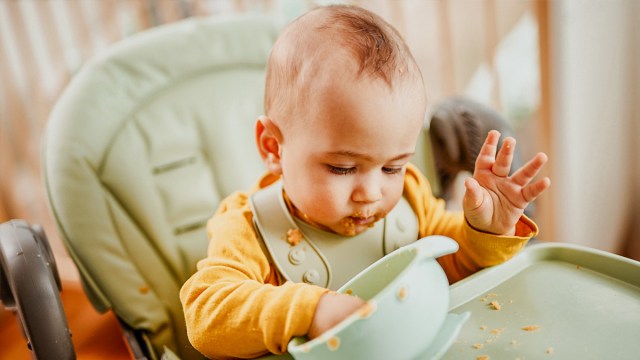You’ve boiled those carrots, cut up the grape tomatoes so they won’t choke, and readied the never-fail nuggets. But we all know what’s going to happen next: Half of that meal is going to end up on the floor. It’s such a common problem that there are even baby plates that suction to their high chair tray so your little one can’t chuck their whole dinner across the room.
Our instinct is to say “No! Stop throwing your food” or “Don’t throw your plate.” But it’s very hard for babies and even toddlers to understand what ‘stop,’ ‘no,’ and ‘don’t’ mean, explains pediatric speech pathologist and mom of two Cassidy Anderson. That’s especially the case when those words land in the middle of a sentence, she says. Cassidy offers several alternatives when you are trying to curb this bad behavior. “What we want to do instead is to tell baby where we want the food, what the food is for, and leave that last [in the direction].”
@cassidyandkids Lets stop that food throwing & get your baby/toddler actually eating ✨ #momtok #parentsoftiktok #startingsolids #toddlersoftiktok #toddlerbehavior #foodthrowing #babyledweaning #toddlermeals #babymeals #babyfood #pickyeater #pickytoddler #blwideas #babythrowingfood #slpsoftiktok #slpmom #newparents #parentingtips #firsttimemom
♬ original sound – Cassidy Anderson & kids
Some example phrases Cassidy suggests using instead of “We don’t throw food” are:
- “Food is for eating.”
- “We want it on.” (pointing to the tray)
- “Uh-oh. That food is all done.”
- “Throwing shows me all done.”
- “Keep the food on.” (pointing to the plate)
Once you’ve said this, and they throw again (like you know they will), you take the plate away from them and say, “Throwing shows me all done. I’m going to take this for now, and if you’re still hungry, you can try again.” Cassidy goes on to explain that if they reach out or say they are still hungry, then you give them the food again and say, “Food is for eating. Throwing shows me all done. Keep the food on.” If the child throws a third time, then they’re really all done, they get taken down from the high chair, and the food goes away.
Cassidy suggests handling it this way because we don’t “ever want food to feel like a reward or discipline. We want to try and stay as neutral as possible with our emotions. When you give a lot of attention to throwing and have big reactions when your baby or toddler throws, we know in child development that they are just probably going to do that more,” she explains. “We’re going to try and keep it cool and keep our language the same throughout.”
In a follow-up video, Cassidy provides a few other ways to curb the food-throwing habit:
- Take the tray off the high chair and move the child up to the table. This makes them feel like they are more a part of mealtime, and they’ll be less inclined to throw food off the sides.
- Offer an “all done bowl” where the child can discard things they don’t want to eat. This teaches that it is okay to not want to eat something, but it’s not okay to throw it on the floor.
- Change up their dinnerware. By introducing a new plate, cup, or piece of silverware, you are mixing things up, and the novelty makes them more interested.
- Sit at the table with your child for family mealtime (when possible). By modeling eating without the distractions of phones or TV, you are encouraging good eating habits for your kids.
These strategies aren’t going to work all the time, but maybe making a few of them part of your everyday routine will lead to less stressful mealtimes and less food wasted.
